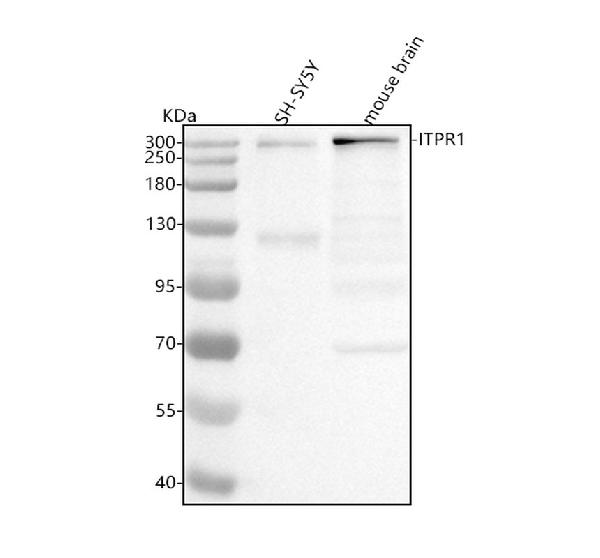Anti-IP3 Receptor Rabbit Monoclonal Antibody
- SPECIFICATION
- CITATIONS
- PROTOCOLS
- BACKGROUND

Application
| WB, IHC, IP |
|---|---|
| Primary Accession | Q14643 |
| Host | Rabbit |
| Isotype | IgG |
| Reactivity | Rat, Human, Mouse |
| Clonality | Monoclonal |
| Format | Liquid |
| Description | Anti-IP3 Receptor Rabbit Monoclonal Antibody . Tested in WB, IHC, IP applications. This antibody reacts with Human, Mouse, Rat. |
| Gene ID | 3708 |
|---|---|
| Other Names | Inositol 1, 4, 5-trisphosphate-gated calcium channel ITPR1, IP3 receptor isoform 1, IP3R 1, InsP3R1, Inositol 1, 4, 5 trisphosphate receptor, Inositol 1, 4, 5-trisphosphate receptor type 1, Type 1 inositol 1, 4, 5-trisphosphate receptor, Type 1 InsP3 receptor, ITPR1 {ECO:0000303|PubMed:7852357, ECO:0000312|HGNC:HGNC:6180} |
| Calculated MW | 313929 Da |
| Application Details | WB 1:500-1:2000 IHC 1:500-1:1000 IP 1:50 |
| Contents | Rabbit IgG in phosphate buffered saline, pH 7.4, 150mM NaCl, 0.02% sodium azide and 50% glycerol, 0.4-0.5mg/ml BSA. |
| Clone Names | Clone: 17I50 |
| Immunogen | A synthesized peptide derived from human IP3 Receptor |
| Purification | Affinity-chromatography |
| Storage | Store at -20°C for one year. For short term storage and frequent use, store at 4°C for up to one month. Avoid repeated freeze-thaw cycles. |
| Name | ITPR1 {ECO:0000303|PubMed:7852357, ECO:0000312|HGNC:HGNC:6180} |
|---|---|
| Function | Inositol 1,4,5-trisphosphate-gated calcium channel that, upon inositol 1,4,5-trisphosphate binding, mediates calcium release from the endoplasmic reticulum (ER) (PubMed:10620513, PubMed:27108797). Undergoes conformational changes upon ligand binding, suggesting structural flexibility that allows the channel to switch from a closed state, capable of interacting with its ligands such as 1,4,5- trisphosphate and calcium, to an open state, capable of transferring calcium ions across the ER membrane (By similarity). Cytoplasmic calcium released from the ER triggers apoptosis by the activation of CAMK2 complex (By similarity). Involved in the regulation of epithelial secretion of electrolytes and fluid through the interaction with AHCYL1 (By similarity). Part of a complex composed of HSPA9, ITPR1 and VDAC1 that regulates mitochondrial calcium-dependent apoptosis by facilitating calcium transport from the ER lumen to the mitochondria intermembrane space thus providing calcium for the downstream calcium channel MCU that directly releases it into mitochondria matrix (By similarity). Regulates fertilization and egg activation by tuning the frequency and amplitude of calcium oscillations (By similarity). |
| Cellular Location | Endoplasmic reticulum membrane; Multi-pass membrane protein {ECO:0000250|UniProtKB:P29994, ECO:0000255} Cytoplasmic vesicle, secretory vesicle membrane {ECO:0000250|UniProtKB:Q9TU34}; Multi-pass membrane protein {ECO:0000250|UniProtKB:P29994, ECO:0000255}. Cytoplasm, perinuclear region. Note=Found in a complex with HSPA9 and VDAC1 at the endoplasmic reticulum-mitochondria contact sites. {ECO:0000250|UniProtKB:P29994} |
| Tissue Location | Widely expressed.. |

Thousands of laboratories across the world have published research that depended on the performance of antibodies from Abcepta to advance their research. Check out links to articles that cite our products in major peer-reviewed journals, organized by research category.
info@abcepta.com, and receive a free "I Love Antibodies" mug.
Provided below are standard protocols that you may find useful for product applications.
If you have used an Abcepta product and would like to share how it has performed, please click on the "Submit Review" button and provide the requested information. Our staff will examine and post your review and contact you if needed.
If you have any additional inquiries please email technical services at tech@abcepta.com.













 Foundational characteristics of cancer include proliferation, angiogenesis, migration, evasion of apoptosis, and cellular immortality. Find key markers for these cellular processes and antibodies to detect them.
Foundational characteristics of cancer include proliferation, angiogenesis, migration, evasion of apoptosis, and cellular immortality. Find key markers for these cellular processes and antibodies to detect them. The SUMOplot™ Analysis Program predicts and scores sumoylation sites in your protein. SUMOylation is a post-translational modification involved in various cellular processes, such as nuclear-cytosolic transport, transcriptional regulation, apoptosis, protein stability, response to stress, and progression through the cell cycle.
The SUMOplot™ Analysis Program predicts and scores sumoylation sites in your protein. SUMOylation is a post-translational modification involved in various cellular processes, such as nuclear-cytosolic transport, transcriptional regulation, apoptosis, protein stability, response to stress, and progression through the cell cycle. The Autophagy Receptor Motif Plotter predicts and scores autophagy receptor binding sites in your protein. Identifying proteins connected to this pathway is critical to understanding the role of autophagy in physiological as well as pathological processes such as development, differentiation, neurodegenerative diseases, stress, infection, and cancer.
The Autophagy Receptor Motif Plotter predicts and scores autophagy receptor binding sites in your protein. Identifying proteins connected to this pathway is critical to understanding the role of autophagy in physiological as well as pathological processes such as development, differentiation, neurodegenerative diseases, stress, infection, and cancer.


